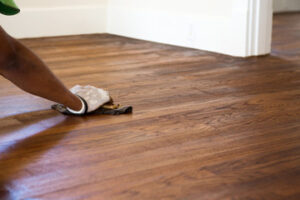Different Types of Flooring for Different Rooms in Your Home
Your floor is one of the most important design elements in your home. It needs to be durable and practical and complement your room’s style.
Natural stone and hardwood floors add value to your home. Tile is great for kitchens and mudrooms. The carpet offers warmth, comfort, and acoustic privacy. And laminate and vinyl are durable, low-maintenance options. For professional help, contact Flooring Fairfield NJ now!
Almost any homeowner can appreciate the natural beauty and warmth that hardwood floors add to a room. Hardwood is also very durable and can last for decades. Whether it’s a bedroom, kitchen or living area, hardwood flooring can enhance the look of any home and increase its resale value.
Hardwood floors can be made of solid or engineered wood. Engineered planks are created by bonding a thin veneer of hardwood to a base of plywood or MDF. Some types of engineered hardwood are created with a click-lock system in which the planks interlock at the edges, making them very easy for DIYers to install. Solid planks are traditionally nailed or glued to the subfloor.
Solid wood planks can be kiln dried or air dried before they are sawed to size for installation. They are then either packed unfinished for a site-finished installation or finished at the factory. The finish is a protective sealer that helps to resist moisture, staining and mold growth.
Unlike carpet or vinyl, hardwood does not trap dust and dirt. It is easy to sweep and vacuum, and it can be mopped using a gentle cleaning solution. However, it is important to check for signs of moisture damage such as molds or fungus. These problems can occur due to excessive moisture in a room or when the water seeps into gaps between the hardwood and subflooring.
Ceramic Tile
Ceramic tile is a popular choice for kitchen and bathroom floors. These tiles are nonporous, so they don’t absorb odors or bacteria, and they can be easily wiped down with water and mild detergents. They’re also highly durable and stain resistant. Ceramic tile is available in a variety of colors, patterns and textures. It’s an ideal choice if you want to add visual interest to your home.
Depending on the type of ceramic tile you choose and its collection, you can use this flooring in low-traffic areas. These include rooms with showers and bathtubs, entryways, laundry areas, powder rooms and kitchens. Most ceramic tile is glazed, so it’s waterproof and stain-resistant. The glazed surface also hides dirt and scratches. Ceramic tile’s thickness, composition and firing temperature determine its strength. Ceramic tiles are rated by the Porcelain Enamel Institute (PEI) according to their wear resistance. PEI class 1 tiles are designed for walls only; class 2 tiles can withstand light to moderate traffic in residential floors; and class 3 can handle heavy traffic in commercial floor applications.
Unglazed ceramic tile is available in a wide range of colors and finishes and is often used to create unique, designer wall applications. Using various patterns and textures, these tiles can make a statement in any room. The natural look of this material can add warmth to your living spaces or help you achieve a sleek, contemporary design. Mosaics are another great way to express your personal style with this versatile tile. These mesh-backed sheets are composed of small 1″ x 1″ or 2″ x 2″ tiles that can be assembled into any installation pattern and feature vibrant contrasting colors and shapes to express your unique personality.
Vinyl
Many homeowners think of the vinyl sheet flooring Mom had in her kitchen or stick-down tiles you ripped up in college when they mention “vinyl” — but today’s high quality solid and luxury vinyl (LVT) floors look nothing like the cheap product of the past. They’re synthetic man-made flooring that can be made to look like a natural material at a typically lower price point. Both have a durable clear coat wear layer that stands up to sunlight and heavy traffic, and photographic design layers that can make them look like wood, stone or ceramic.
Both are economical, water-resistant and come in a wide variety of patterns, colors, finishes and designs. They’re particularly well-suited to busy family areas where spills and scuffs are common. Vinyl resists dents, stains and scratches better than most other flooring types and can be easily wiped clean of dirt, food or drink spills, and pet messes.
A special urethane finish provides added protection against scuffing, staining and fading. Some manufacturers also include antimicrobial properties in the wear layer to reduce the growth of mold and mildew.
Vinyl is also available in the more durable and expensive form of vinyl composition tile (VCT) or in cushioned sheets that have closed-cell-foam lower layers for a soft feel underfoot. Some of these newer products are certified low in VOCs (volatile organic compounds) by an industry group and require less maintenance than traditional vinyl. Even low-VOC options, however, emit chemicals such as phenol that can build up in poorly ventilated rooms and cause harm to your health.
Laminate
Laminate is a popular flooring choice for modern homes that are looking to create a stylish look on a budget. It is a durable synthetic flooring product that is resistant to stains, scratches and fading. It is a great option for homes with children and pets, since it can withstand heavy foot traffic. It is easy to clean and requires no special cleaning products, but regular care will keep your laminate looking like new.
To manufacture laminate flooring, four or five layers of materials are bonded together to form the planks. The bottom plastic layer serves as a moisture barrier, and the core is made of high-density fiberboard or wood particle board that has been heated and compressed for rigidity. A decorative layer of multiple sheets of photo paper fused with melamine resin gives the laminate its realistic look. A protective top wear layer is usually made of a hard, clear film that resists damage and stains. Some manufacturers also use aluminum oxide particles and melamine resin in this top layer to offer added moisture protection.
Some types of laminate floors feature a textured surface or embossed image layer that replicates the appearance of brushed, wire-brushed or hand-scraped natural materials. This texture can also reduce the amount of dust trapped on the surface, which is a benefit for people with respiratory conditions or allergies to house dust mites.
Most laminate floors are installed using a floating floor system, in which the planks are secured to each other without being directly attached to the subfloor. A padded underlayment may be placed on top of the planks, which helps to reduce noise and protect the subfloor from moisture.
Carpet
Carpet is a soft floor covering that provides warmth and comfort underfoot. It can also offer thermal insulation and improve noise reduction, making it a popular choice for bedrooms and living rooms. Carpeting is typically made from fibers that are woven or tufted together to create a soft surface and can be made with either natural or synthetic materials. The type of fiber used to make the carpet can determine its color, durability and overall quality. There are several different types of carpeting available, including nylon, polyester and polypropylene. Nylon is the most popular synthetic carpet fiber, as it offers superior performance in appearance retention, fade and heat resistance, soil and stain resistance and color stability. Other natural fibers, such as sisal and seagrass, can provide a more unique look and are often more sustainable than synthetic options.
Tufted carpets have their pile injected with a tufting gun into a primary backing material and then bonded to a secondary backing consisting of either hessian or a manmade alternative that adds strength and stability to the carpet. There are also woven carpets, such as kilim, soumak and ingrain. These are created by interlocking warp (vertical) and weft (horizontal) threads.
Tufted and woven carpets come in a variety of pile heights, with shag being the most popular in the past. Nowadays, low-profile pile carpets are a more common option as they hold up better to foot traffic and are easier to clean. Carpeting can also be found in a variety of textures, from short, snaggy fibers to long, lush fibers that are perfect for creating a luxurious feel and adding depth to the room.
